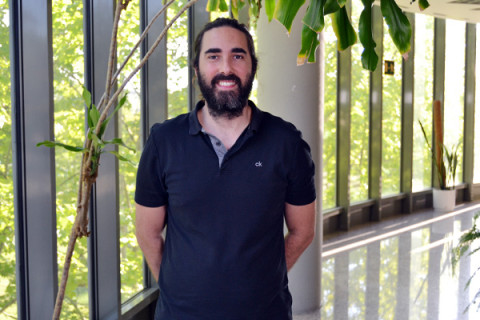Álvaro Jiménez joins ICMM thanks to a Talento CAM Fellowship

Álvaro Jiménez joined the Theory of Quantum Materials and Solid State Technologies (TQE) group for five years during 2023. In this time, he will develop his own project: QUMATTO (QUantum Materials probed with ATTOsecond techniques). Meet him here:
Where do you came from?
I'm from Madrid. I received my PhD on "Theoretical Chemistry and Computational Modelling" from the Universidad Autónoma de Madrid in 2015 under the supervision of Fernando Martín and Luca Argenti. As a postdoc, I moved to Berlin to work in the group of Misha Ivanov at the Max-Born-Institut, where I stayed 6 years. In 2021, I obtained a Marie Curie Fellowship to work at the laboratory of Paul Corkum and Giulio Vampa at the National Research Council of Canada in Ottawa, Canada, where I stayed for the last year and a half. I am now very excited to return to Madrid and join the ICMM!
What have you worked on so far?
During my PhD, I studied theoretically the correlated electron dynamics of atomic autoionizing states using attosecond technology, which allowed to see for the first time the formation of a Fano resonance in time. During my postdoc, I worked on using strong laser fields, sculpted at the level of individual oscillations, to steer coherent electron motion in atoms and solids. We predicted that these fields allowed to induce controlled changes in the band structure of 2D materials on few-femtosecond timescales. During my recent 1.5-year stay at the laboratories of the National Research Council in Canada, I performed high harmonic generation experiments in hexagonal monolayers. It was great to experience what is really going on in the lab!
What will you work on? With whom?
I will develop my own project "QUMATTO" (QUantum Materials probed with ATTOsecond techniques). This project is at the intersection between attosecond physics and 2D materials. I will use and develop theoretical methodologies that will guide and interpret attosecond and strong-field experiments in quantum materials. These include but are not limited to 2D monolayers, heterolayers and topological insulators. I will explore how to manipulate the electronic and topological properties of quantum materials on ultrafast timescales by studying the light-driven electron motion in the crystal through perturbative and highly non-perturbative optical techniques (e.g., RABBIT, high harmonic generation).
I will continue the fruitful collaboration with Rui Silva that we had over the last 5 years, and will also work closely with Pablo San-José, whose line of research aligns with mine. I will also work towards collaborating with more people from the TQE group, as well as experimental colleagues at ICMM.
Why did you choose ICMM?
ICMM has world-leading expertise on low-dimensional materials, both from the experimental and theoretical side. During the last three years, the TQE group has started to build synergies between the fields of attosecond strong-field physics and quantum materials thanks to the efforts of Rui Silva and Pablo San-José. The combination of theoretical know-how in these fields is unique in Spain. In fact, very few institutions in the world have it at the moment. I believe the ICMM is in a wonderful position to become one of the main world hubs of theoretical attosecond physics in quantum materials at the femto- and atto-scale. We already collaborate with several international experimental groups on this topic (Stanford University, Weizmann Institute, National Research Council of Canada, Imperial College, ICFO), and would like to work further in building close in-house collaborations.
And a personal touch: any hobbies? What would you like to contribute to the institute?
Of course! I love to play guitar; lately I am into Spanish classical guitar. In fact, I tried to make it as a musician before becoming a physicist. I also practice Taekwondo since 25 years.
Instituto de Ciencia de Materiales de Madrid (ICMM)
Sor Juana Ines de la Cruz, 3
Cantoblanco, 28049
Madrid, España
Telephone: (+34) 91 334 90 00
Email: @email
Communication Office: @email

Acknowledge the Severo Ochoa Centres of Excellence program through Grant CEX2024-001445-S/ financiado por MICIU/AEI / 10.13039/501100011033

Contacto | Accesibilidad | Aviso legal | Política de Cookies | Protección de datos